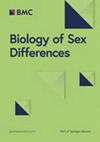Application and insights of targeted next-generation sequencing in a large cohort of 46,XY disorders of sex development in Chinese
IF 4.9
2区 医学
Q1 ENDOCRINOLOGY & METABOLISM
引用次数: 0
Abstract
46,XY disorders of sex development (46,XY DSD) are characterized by incomplete masculinization of genitalia with reduced androgenization. Accurate clinical management remains challenging, especially based solely on physical examination. Targeted next-generation sequencing (NGS) with known pathogenic genes provides a powerful tool for diagnosis efficiency. This study aims to identify the prevalent genetic variants by targeted NGS technology and investigate the diagnostic rate in a large cohort of 46,XY DSD patients, with most of them presenting atypical phenotypes. Two different DSD panels were developed for sequencing purposes, targeting a cohort of 402 patients diagnosed with 46,XY DSD, who were recruited from the Department of Urology at Children’s Hospital, Zhejiang University School of Medicine (Hangzhou, China). The detailed clinical characteristics were evaluated, and peripheral blood was collected for targeted panels to find the patients’ variants. The clinical significance of these variants was annotated according to American College of Medical Genetics and Genomics (ACMG) guidelines. A total of 108 variants across 42 genes were found in 107 patients, including 46 pathogenic or likely pathogenic variants, with 45.7%(21/46) being novel. Among these genes, SRD5A2, AR, FGFR1, LHCGR, NR5A1, CHD7 were the most frequently observed. Besides, we also detected some uncommon causative genes like SOS1, and GNAS. Oligogenic variants were also identified in 9 patients, including several combinations PROKR2/FGFR1/CYP11B1, PROKR2/ATRX, PROKR2/AR, FGFR1/LHCGR/POR, FGFR1/NR5A1, GATA4/NR5A1, WNT4/AR, MAP3K1/FOXL2, WNT4/AR, and SOS1/FOXL2. The overall genetic diagnostic rate was 11.2%(45/402), with an additional 15.4% (62/402) having variants of uncertain significance. Additionally, trio/duo patients had a higher genetic diagnostic rate (13.4%) compared to singletons (8.6%), with a higher proportion of singletons (15.1%) presenting variants of uncertain significance. In conclusion, targeted gene panels identified pathogenic variants in a Chinese 46,XY DSD cohort, expanding the genetic understanding and providing evidence for known pathogenic genes’ involvement. 46,XY disorders of sex development (46,XY DSD) are conditions where individuals don’t fully develop male genitalia due to reduced androgen hormones. Diagnosing these conditions based only on physical exams is difficult. This study used advanced genetic testing called targeted next-generation sequencing (NGS) to identify common genetic variations in a large group of 46,XY DSD patients, many of whom had unusual symptoms. We examined 402 patients with DSD and a 46,XY karyotype, focusing on 142 candidate genes related to sex development. We found genetic variations in 107 patients, including 45 that were likely responsible for their condition. Some of these variations were new discoveries. The most commonly affected genes were SRD5A2, AR, FGFR1, LHCGR, NR5A1, CHD7. We also found that some patients had variations in multiple genes, suggesting complex genetic causes. Overall, we were able to diagnose 11.2% of patients based on our genetic testing, with another15.4% having uncertain results. Patients tested as a trio or duo (with their parents) had a higher diagnosis rate than those tested alone. This study helps expand our understanding of the genetic factors behind 46,XY DSD in the Chinese population. Two gene panels were designed, comprising 142 and 271 candidate genes associated with sex development, to sequence 402 patients with 46,XY DSD. A total of 108 variants across 42 genes were identified in 107 patients, with 46 classified as pathogenic or likely pathogenic, including several novel variants. SRD5A2, AR, FGFR1, LHCGR, NR5A1, CHD7 were among the most frequently observed genes with variants. The overall genetic diagnostic rate was 11.2%, with an additional 15.4% of patients having variants of uncertain significance, and oligogenic variants were detected in 9 patients, suggesting complex genetic interactions in 46,XY DSD. Patients with trio/duo genetic information had a higher genetic diagnostic rate (13.4%) compared to singletons (8.6%), underscoring the importance of parental genetic data. Phenotypic variability and potential genetic heterogeneity underscore the complexity of 46,XY DSD, highlighting the necessity for further research and multi-center collaboration.定向新一代测序在中国 46,XY 性别发育障碍大样本中的应用和启示
46,XY性发育障碍(46,XY DSD)的特点是生殖器不完全男性化,雄激素分泌减少。准确的临床管理仍然具有挑战性,尤其是仅凭体格检查。已知致病基因的靶向新一代测序(NGS)为提高诊断效率提供了有力工具。本研究旨在通过靶向 NGS 技术鉴定普遍存在的基因变异,并调查一大批 46,XY DSD 患者的诊断率。为了测序目的,我们开发了两种不同的 DSD 面板,目标人群是浙江大学医学院附属儿童医院(中国杭州)泌尿外科的 402 名确诊为 46,XY DSD 的患者。研究人员对这些患者的详细临床特征进行了评估,并采集了他们的外周血进行靶向分析,以发现他们的变异基因。根据美国医学遗传学和基因组学学院(ACMG)指南,对这些变异的临床意义进行了注释。在107名患者的42个基因中共发现108个变异,包括46个致病或可能致病的变异,其中45.7%(21/46)为新变异。在这些基因中,SRD5A2、AR、FGFR1、LHCGR、NR5A1、CHD7是最常见的变异。此外,我们还发现了一些不常见的致病基因,如 SOS1 和 GNAS。我们还在 9 例患者中发现了寡基因变异,包括 PROKR2/FGFR1/CYP11B1、PROKR2/ATRX、PROKR2/AR、FGFR1/LHCGR/POR、FGFR1/NR5A1、GATA4/NR5A1、WNT4/AR、MAP3K1/FOXL2、WNT4/AR 和 SOS1/FOXL2。总体基因诊断率为 11.2%(45/402),另有 15.4%(62/402)的变异意义不确定。此外,三人/二人患者的基因诊断率(13.4%)高于单人患者(8.6%),单人患者中出现意义不确定变异的比例更高(15.1%)。总之,在中国 46,XY DSD 群体中,有针对性的基因面板鉴定出了致病变异,拓展了对遗传学的理解,并为已知致病基因的参与提供了证据。46,XY性发育障碍(46,XY DSD)是指由于雄性激素减少导致男性生殖器发育不完全。仅靠体格检查很难诊断出这些疾病。这项研究采用了先进的基因检测方法,即定向下一代测序(NGS),在一大群46,XY DSD患者中确定常见的基因变异,其中很多人都有不寻常的症状。我们研究了 402 名患有 DSD 且核型为 46,XY 的患者,重点研究了 142 个与性发育相关的候选基因。我们在 107 名患者中发现了基因变异,其中 45 个基因变异很可能是导致他们患病的原因。其中一些变异是新发现的。最常受影响的基因是 SRD5A2、AR、FGFR1、LHCGR、NR5A1 和 CHD7。我们还发现,一些患者的多个基因都存在变异,这表明遗传原因很复杂。总体而言,我们通过基因检测确诊了 11.2% 的患者,另有 15.4% 的患者结果不确定。与单独检测的患者相比,三人或两人(与父母一起)检测的患者诊断率更高。这项研究有助于我们进一步了解中国人群中 46,XY DSD 的遗传因素。该研究设计了两个基因片段,分别由142个和271个与性发育相关的候选基因组成,对402名46,XY DSD患者进行测序。在107名患者中发现了42个基因中的108个变异,其中46个被归类为致病或可能致病,包括几个新变异。SRD5A2、AR、FGFR1、LHCGR、NR5A1、CHD7 是最常见的变异基因。总体基因诊断率为11.2%,另有15.4%的患者存在意义不确定的变异,9名患者检测到寡源性变异,这表明46,XY DSD存在复杂的基因相互作用。与单基因患者(8.6%)相比,三基因/双基因患者的基因诊断率更高(13.4%),这凸显了父母基因数据的重要性。表型变异和潜在的遗传异质性凸显了46,XY DSD的复杂性,强调了进一步研究和多中心合作的必要性。
本文章由计算机程序翻译,如有差异,请以英文原文为准。
求助全文
约1分钟内获得全文
求助全文
来源期刊

Biology of Sex Differences
ENDOCRINOLOGY & METABOLISM-GENETICS & HEREDITY
CiteScore
12.10
自引率
1.30%
发文量
69
审稿时长
14 weeks
期刊介绍:
Biology of Sex Differences is a unique scientific journal focusing on sex differences in physiology, behavior, and disease from molecular to phenotypic levels, incorporating both basic and clinical research. The journal aims to enhance understanding of basic principles and facilitate the development of therapeutic and diagnostic tools specific to sex differences. As an open-access journal, it is the official publication of the Organization for the Study of Sex Differences and co-published by the Society for Women's Health Research.
Topical areas include, but are not limited to sex differences in: genomics; the microbiome; epigenetics; molecular and cell biology; tissue biology; physiology; interaction of tissue systems, in any system including adipose, behavioral, cardiovascular, immune, muscular, neural, renal, and skeletal; clinical studies bearing on sex differences in disease or response to therapy.
 求助内容:
求助内容: 应助结果提醒方式:
应助结果提醒方式:


